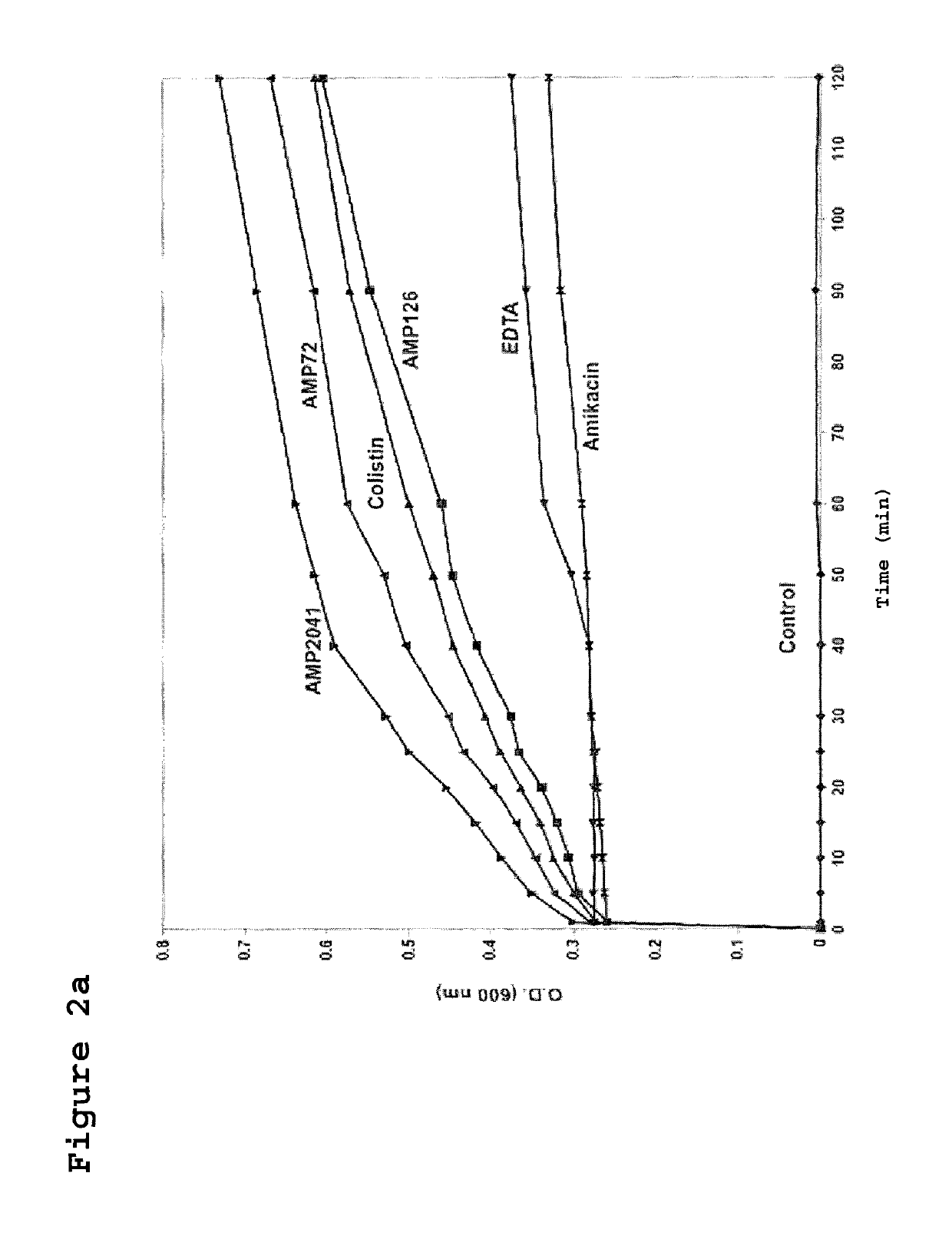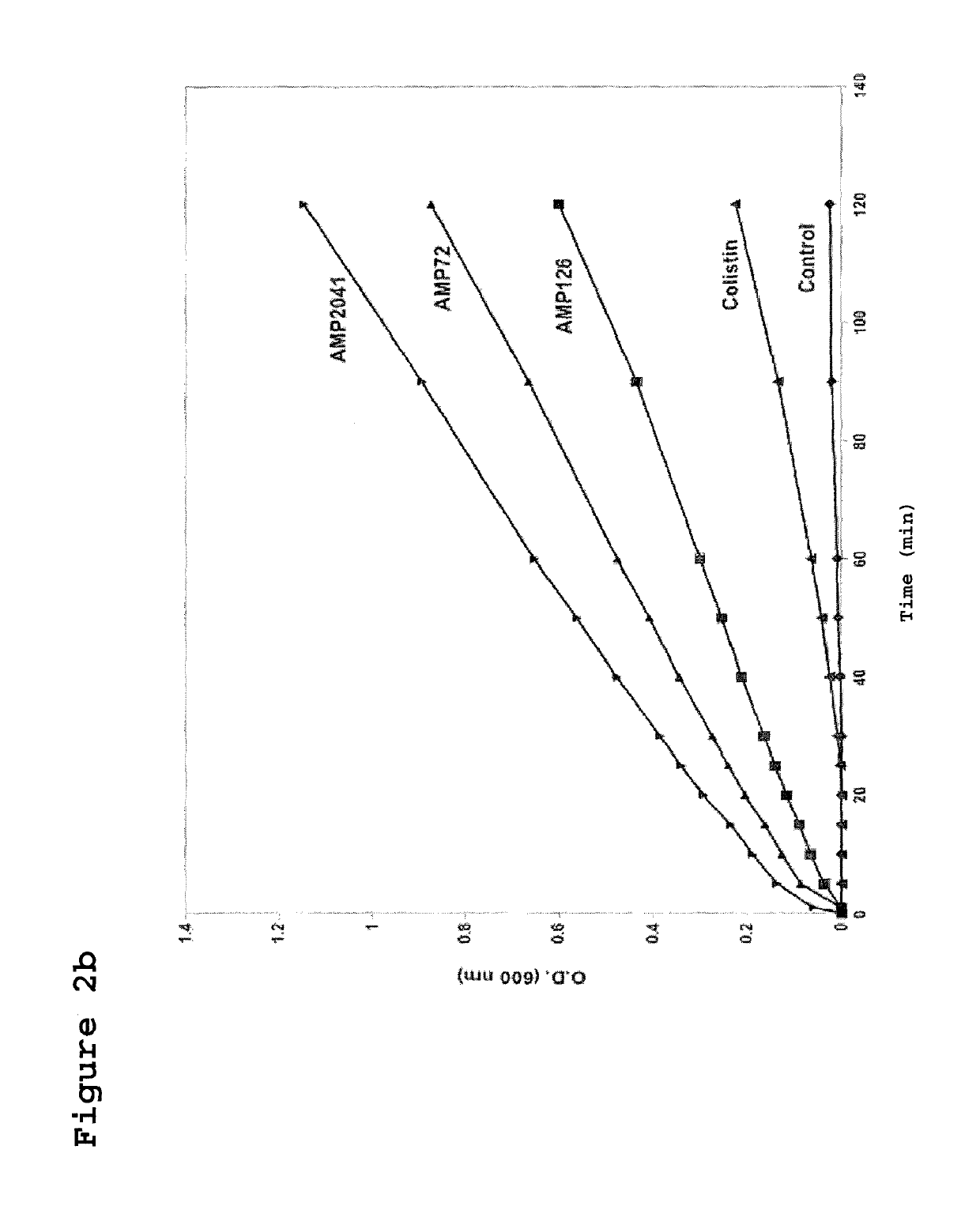Cyclic cationic peptides with antimicrobial activity
a cationic peptide and antimicrobial technology, applied in the field of cyclic or cyclizable cationic peptides with antimicrobial activity, can solve the problems of reducing the possibility of an efficient treatment, reducing the number of new marketed molecules, and inability of pharmaceutical industries to identify new antimicrobial compounds
- Summary
- Abstract
- Description
- Claims
- Application Information
AI Technical Summary
Benefits of technology
Problems solved by technology
Method used
Image
Examples
example 1
Synthesis of Peptides
[0119]Method
[0120]Synthesis of the peptides was performed by the company SelleckChem, through its associate in the United States. The synthesis was carried out by techniques known in the art and specifically by solid phase synthesis.
[0121]Results
[0122]100 peptides were synthesized, having length of 17 amino acids and a degree of purity comprised between 78 and 90%. The peptides were delivered in a 96-well plate containing 2-5 mg of freeze-dried peptide+4 cryovials containing the remaining 4 peptides. The technical report attached to the peptides did not highlight problems during the synthesis. In FIG. 1 the structure of the peptides is schematized.
example 2
Membrane Permeabilization Assay Using the Bacterial Strain E. coli ML-35pYC
[0123]Methods
[0124]The strain ML-35pYC of E. coli was used to assay the kinetics of membrane permeabilization performed by the peptides of the invention. This bacterial strain expresses resistance to ampicillin, constitutive expression of cytoplasmic beta-galactosidase, and is engineered with a plasmid for the synthesis of a periplasmic beta-lactamase. Sixty microliters (60 μl) of bacterial suspension of strain ML-35pYC of E. coli were added to 60 μl of a 15 mM solution of ONPG or 1.5 mM of CENTA in phosphate buffer. Subsequently, 120 μl of the test peptides were added to obtain a final concentration of 12.5 μg / ml. The kinetics of the reaction was evaluated by recording the value of absorbance at 600 nm and 405 nm, for ONPG and CENTA respectively, every 10 min up to a maximum of 240 min.
[0125]Results
[0126]In FIGS. 2A and 2B the permeabilization curves relative to the 3 tested peptides are reported. When value...
example 3
Determination of the Spectrum of Activity and Efficacy of Antimicrobial Peptides on Gram-Negative Bacteria
[0129]This example demonstrates the spectrum of activity and efficacy of the tested peptides against Escherichia coli ATCC 25922, Pseudomonas aeruginosa ATCC 27853 and Stenotrophomonas maltophilia ATCC 13637. LD90s were determined for each peptide and for each strain tested.
[0130]Methods
[0131]a) Preparing the Bacterial Inoculum
[0132]For each bacterial strain, 3-5 morphologically similar colonies were drawn from fresh cultures, inoculated in Brain Hearth Infusion broth liquid medium and incubated at the temperature of 37° C. under shaking at 225 r.p.m. for 3-4 h. Subsequently, the bacterial suspension was centrifuged at 1000 g for 20 min and the thus obtained pellet was resuspended in phosphate buffer 10 mM. Turbidity was measured in a spectrophotometer with absorbance at 600 nm, equivalent in the range 0.08-0.13 to a concentration of about 108 CFU / ml. The bacterial suspension wa...
PUM
| Property | Measurement | Unit |
|---|---|---|
| membrane potential | aaaaa | aaaaa |
| polar angle | aaaaa | aaaaa |
| polar angle | aaaaa | aaaaa |
Abstract
Description
Claims
Application Information
 Login to View More
Login to View More - R&D
- Intellectual Property
- Life Sciences
- Materials
- Tech Scout
- Unparalleled Data Quality
- Higher Quality Content
- 60% Fewer Hallucinations
Browse by: Latest US Patents, China's latest patents, Technical Efficacy Thesaurus, Application Domain, Technology Topic, Popular Technical Reports.
© 2025 PatSnap. All rights reserved.Legal|Privacy policy|Modern Slavery Act Transparency Statement|Sitemap|About US| Contact US: help@patsnap.com



